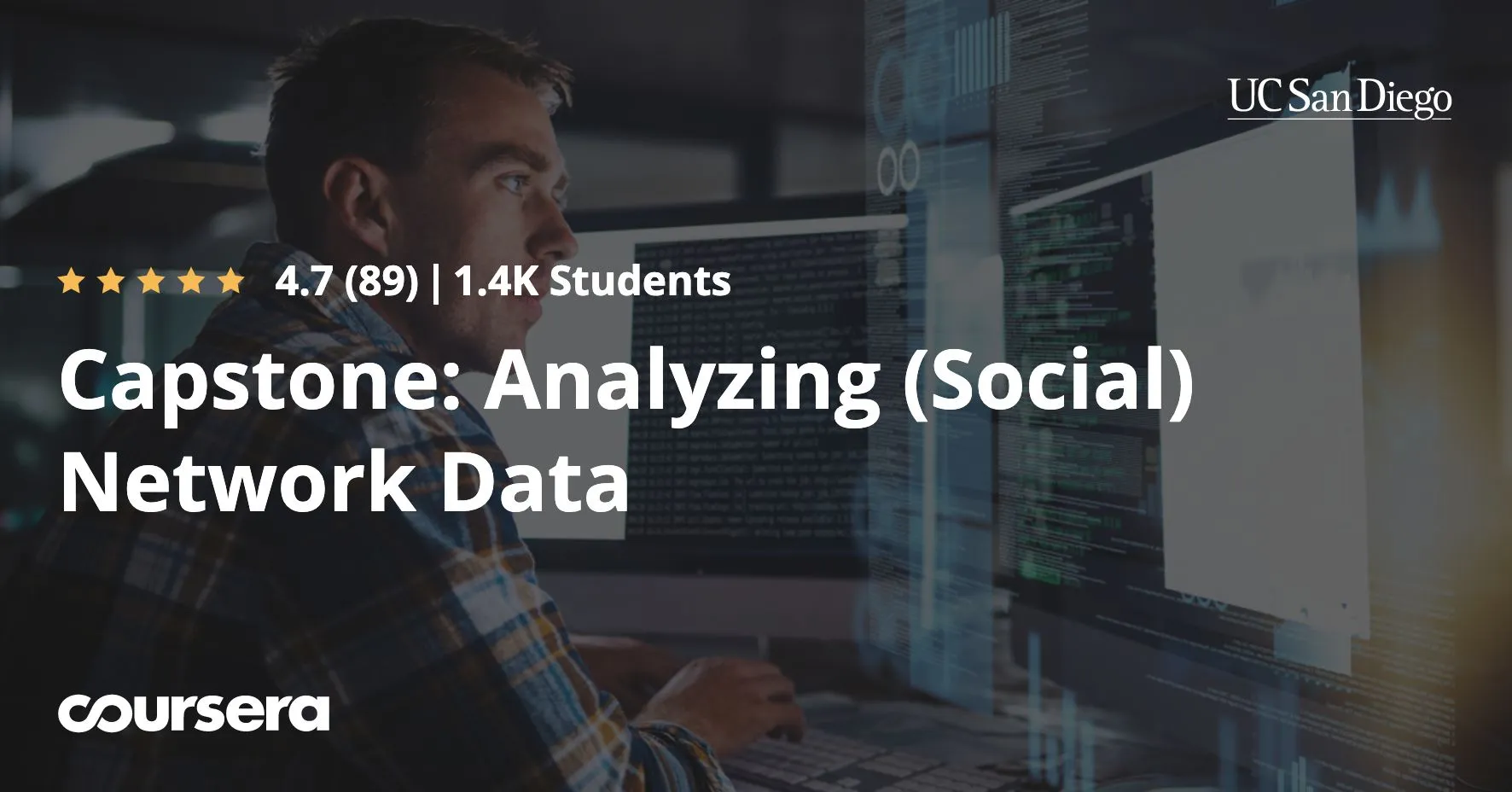
Capstone: Analyzing (Social) Network Data 
In this capstone project, students will use the skills acquired from the four specialization courses to analyze social network data. This project provides an exciting opportunity to explore the dynamics of social networks. ▼
ADVERTISEMENT
Course Feature
![]() Cost:
Cost:
Free
![]() Provider:
Provider:
Coursera
![]() Certificate:
Certificate:
No Information
![]() Language:
Language:
English
![]() Start Date:
Start Date:
Self Paced
Course Overview
❗The content presented here is sourced directly from Coursera platform. For comprehensive course details, including enrollment information, simply click on the 'Go to class' link on our website.
Updated in [March 06th, 2023]
This course provides an introduction to the analysis of (social) network data. Students will learn how to use network analysis techniques to answer questions about the structure and dynamics of networks. They will also learn how to use network visualization tools to explore and interpret network data. By the end of the course, students will be able to identify the most influential members of a network, identify sub-communities, and understand the structure of the network.
[Applications]
The application of this course can be seen in various fields such as marketing, public health, and social sciences. By analyzing social network data, marketers can identify influential members of the network and target them with their campaigns. Public health professionals can use the data to identify sub-communities and target them with health interventions. Social scientists can use the data to study the structure of the network and the relationships between its members. Furthermore, the data can be used to identify potential collaborations and connections between members of the network.
[Career Paths]
1. Data Scientist: Data Scientists are responsible for analyzing large datasets to uncover trends and insights. They use a variety of tools and techniques to uncover patterns and correlations in data. Data Scientists are in high demand as organizations look to leverage data to make better decisions.
2. Social Network Analyst: Social Network Analysts are responsible for analyzing social networks to identify relationships between people, groups, and organizations. They use a variety of tools and techniques to uncover patterns and correlations in data. Social Network Analysts are in high demand as organizations look to leverage social networks to better understand their customers and target markets.
3. Machine Learning Engineer: Machine Learning Engineers are responsible for developing and deploying machine learning models. They use a variety of tools and techniques to build models that can be used to make predictions and decisions. Machine Learning Engineers are in high demand as organizations look to leverage machine learning to automate processes and make better decisions.
4. Data Visualization Specialist: Data Visualization Specialists are responsible for creating visual representations of data. They use a variety of tools and techniques to create visualizations that can be used to better understand data and uncover insights. Data Visualization Specialists are in high demand as organizations look to leverage data visualizations to better understand their data.
[Education Paths]
1. Bachelor of Science in Computer Science: This degree path focuses on the fundamentals of computer science, including programming, algorithms, data structures, and software engineering. It also covers topics such as artificial intelligence, machine learning, and computer networks. With the increasing demand for data-driven solutions, this degree path is becoming increasingly popular.
2. Master of Science in Data Science: This degree path focuses on the application of data science techniques to solve real-world problems. It covers topics such as data mining, machine learning, and statistical analysis. It also covers topics such as natural language processing, computer vision, and deep learning. With the increasing demand for data-driven solutions, this degree path is becoming increasingly popular.
3. Master of Science in Artificial Intelligence: This degree path focuses on the development of intelligent systems and their applications. It covers topics such as machine learning, natural language processing, computer vision, and robotics. With the increasing demand for intelligent systems, this degree path is becoming increasingly popular.
4. Doctor of Philosophy in Social Network Analysis: This degree path focuses on the analysis of social networks and their applications. It covers topics such as network structure, network dynamics, and network visualization. With the increasing demand for data-driven solutions, this degree path is becoming increasingly popular.
Pros & Cons

Learn a lot of things

Flexible project scope

Combines skills from previous courses

Great supplement to degree

Learn Java programming and associated technologies

Difficulty following instructor

Complicated for some students

Time consuming to find dataset and project idea
Course Provider

Provider Coursera's Stats at AZClass
Discussion and Reviews
0.0 (Based on 0 reviews)
Explore Similar Online Courses

Certified Tester ISTQB Foundation Level (CTFL) Updated 2022

Practice Classes in JavaScript Course

Digital Marketing 101 (A Beginner's Guide To Marketing)

5 Explosive Digital Marketing Strategies for 2023 (BIG Changes Ahead!)

Twitter for Business

Digital Marketing Course

Free Email Marketing Course From HubSpot Academy

Social Media Marketing with Advertising Week

Google My Business For a Home Business

Projecting Your Brand Through New Media

Digital Media Analytics: Earned Media


Start your review of Capstone: Analyzing (Social) Network Data